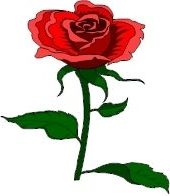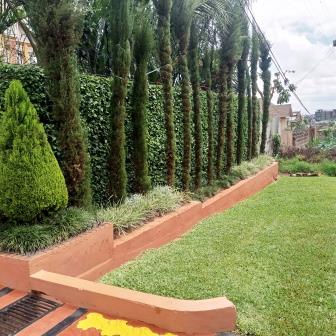What lawn grass should I use?
East Africa is home to a diverse range of climates and landscapes, requiring careful consideration when selecting the right grass for your lawn. In this comprehensive guide, we will explore and compare several popular lawn grasses in the region, providing detailed descriptions, characteristics, advantages, and disadvantages of each.

Kikuyu Grass
Kikuyu grass was first properly described in 1903 by Emili Chiovenda in Kiambaa, Kiambu Central Kenya. It has green leaves folded along the midrib. The blades are thick with runners.
It is a warm-season grass known for its vigorous growth and ability to withstand heavy foot traffic.
It forms a dense, vibrant green carpet that can quickly fill bare areas. Kikuyu grass is highly adaptable to various soil types, but it requires regular mowing and ample water to prevent overgrowth. Left unmowed, it grows into thick unattractive runners and rough foliage only fit for cattle grazing. In large-scale housing projects where Kikuyu grass was the grass of choice, the hum of lawnmowers is a daily experience.

While it excels in full sun, it may struggle in shaded areas. One of the significant advantages of Kikuyu grass is its excellent drought tolerance, making it suitable for regions with limited water availability.
Even when it dries and seems to have “gone” during drought, you will be surprised at how soon it bounces back in the wet season
Once, a client in Limuru asked that we redo their entire lawn as the grass appeared to have died. I advised caution and patience. Barely a fortnight after the rains, she was calling for lawn mower services!
However, its aggressive growth habit can lead to invasiveness if not properly contained.
Kikuyu grass is good for tough surfaces for playing or well-used garden paths and lawns.
Pemba Grass
Pemba grass, also known as Napier grass, is a warm-season grass that thrives in coastal regions and is particularly salt-tolerant
It occurs in two types the right variegated type and the light green type.
Pemba grass has a coarse texture and can reach significant heights, making it suitable for erosion control and as a fodder crop for livestock.
Pemba grass exhibits good drought tolerance and can adapt to a wide range of soil types, including sandy soils. However, its invasive nature requires regular maintenance to prevent it from spreading beyond designated areas.
Zimbabwe grass
Zimbabwe Grass (Rhodes grass) (Chloris gayana): Zimbabwe grass is a warm-season, perennial grass that offers excellent drought tolerance and thrives in dry areas. It forms a dense mat and recovers quickly from wear and tear, making it suitable for high-traffic areas. This grass has a fine texture and exhibits good shade tolerance. Regular mowing and fertilization are necessary to maintain its appearance. Zimbabwe grass prefers well-drained soils and is not suitable for areas with heavy clay.

Cape Royal (Golf grass)
Cape Royal a full-sun grass that has very thin blades and is a little slow to establish. Cape Royal is a cool-season grass that performs well in high-altitude regions with cooler temperatures. It has a dark green color and a fine texture, providing an attractive appearance. Cape Royal exhibits good shade tolerance, making it suitable for areas with limited sunlight. This grass has moderate water requirements and requires regular maintenance, including mowing and fertilization. It is important to note that Cape Royal may struggle in hot, d
It is a choice grass for golf courses and its not uncommon to encounter huge teams plucking weeds for cape royal grass in golf courses
Arabic Grass
Arabic grass, also known as teff grass, is a warm-season grass that is highly tolerant of heavy grazing. Arabic grass establishes quickly and has a dense growth habit. However, it may struggle in shaded areas and prefers full sun. This grass requires regular maintenance to keep it in optimal condition. If you have ample water and you want the best possible lawn, this is the grass to go forThis is grass for high-profile homes as it requires top-notch maintenance, particularly with regard to water.

Paspalum
Paspalum is a warm-season grass that is well-suited for coastal regions and areas with saline soils. It offers high salt tolerance and can withstand occasional flooding. Paspalum has a deep root system, providing good wear resistance. It forms an attractive, dense turf but requires regular fertilization to maintain its appearance. Paspalum may not tolerate heavy shade and is best suited for full-sun conditions and light shade.

Maadi River
Maadi River is a native grass of the Nile region and is well-adapted to the East African climate. It offers good heat and drought tolerance, making it suitable for areas with limited water availability. Maadi River has a coarse texture and is often used for erosion control on slopes. Once established, it requires infrequent mowing and little water. However, it may not be as visually appealing as other grass varieties due to its coarse appearance.

When selecting lawn grass for your East African landscape, it’s important to consider factors such as climate, water availability, shade, and maintenance requirements. Consulting with local experts like Crystal Gardens and considering the specific needs of your lawn will help you make an informed decision. Remember to assess the advantages and disadvantages of each grass variety to ensure a healthy and vibrant lawn for years to come.
Whatever you decide on, always remember a good lawn whichever the grass, is a labor of love. It will not just happen but requires investment in terms of time, labor, and inputs. If you need help with your lawn planting, call on us at Crystal Gardens and we will be happy to help.


Leave a Reply